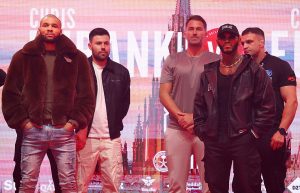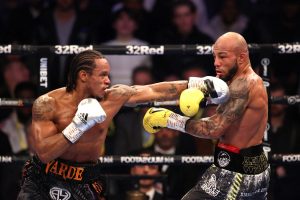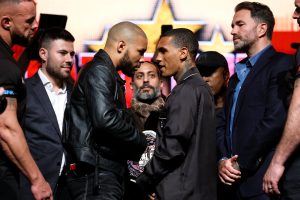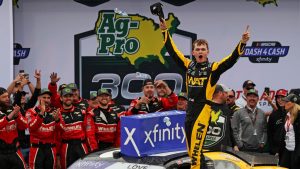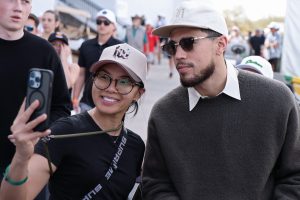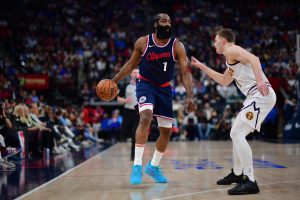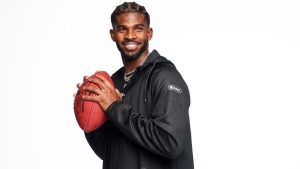The 2025 NFL draft was not without its fair share of first-round drama. But the opening night in Green Bay, Wisconsin, didn’t seem to spark the widespread ridicule that has become inherent to the event in recent years.
With a shortage of stars – particularly at quarterback – the first 32 selections seemingly didn’t drive the same level of divisiveness in the discourse around each decision. And while Thursday had plenty of intriguing moments, there was no true stunner that rose to the level of the Atlanta Falcons taking quarterback Michael Penix Jr. eight overall last year.
Still, more than a few moves raised eyebrows and warranted closer scrutiny. While it’s too early to render definitive verdicts on any selections just yet, these five picks stand out as the most questionable of the draft so far:
1. Tyler Booker, G, Dallas Cowboys (No. 12 overall pick)
Jerry Jones has become a fixture of this yearly rundown, and his recent track record shouldn’t sway many into believing that he’s on the right path when he goes his own way.
With CeeDee Lamb netting nearly twice as many targets (152) and receiving yards (1,194) as the next closest wideout in 2024, Dallas’ receiving corps was clearly in a bad way heading into the offseason. Yet outside of a one-year deal for Parris Campbell, the Cowboys took their usual stance of largely standing pat in free agency. That only amplified the drumbeat for the team to use its top selection on a wide receiver. New coach Brian Schottenheimer even explained earlier in April his belief in building teams outside in, which would have made cornerback or edge rusher sensible alternatives as well.
But this is Jerry’s team, and this is very much Jerry’s pick.
The issue here is not so much with Booker specifically as where it leaves the rest of the roster. Yes, the 6-5, 321-pounder raised some red flags with his athletic profile, but it’s not disqualifying. And there’s a natural appeal in getting the offensive front on solid ground with a powerful presence touted for his leadership.
But the Cowboys can’t afford to wait on premium positions unless they can establish a much better hit rate later in the draft. Embracing that outside-in mentality will be necessary on Friday and Saturday if the organization wants to provide Dak Prescott with sufficient support, but a running back on Day 2 also might be in order. Regardless, this choice seems like a luxury for a team that has plenty on its to-do list.
2. Kenneth Grant, DT, Miami Dolphins (No. 13)
When the Dolphins acknowledged before the draft that they were trying to move seven-time Pro Bowl cornerback Jalen Ramsey, many saw it as the marker of a potential shift in plans. Might a team due for an investment in the trenches instead turn its focus to the secondary?
But the Dolphins affirmed their commitment to better controlling the line of scrimmage by taking Grant. The 6-4, 331-pounder not only demands consistent double teams, but he also offers surprising ability to close out on ball carriers despite his size. With astonishing athleticism for a man in the middle, he has substantial untapped potential as a disruptor.
Still, it was a surprise to see a player who didn’t seem to be a first-round lock end up as the second defensive tackle taken after Grant’s former Michigan teammate Mason Graham. The Dolphins passed on both Walter Nolen and Derrick Harmon, who each have a more extensive track record of creating disruption in the passing game than Grant does.
Lofty comparisons to Dexter Lawrence and Haloti Ngata have been floated for the supersized Grant. If he can ever pose as big of a problem for quarterbacks as either of those two, this pick will be a rousing success. But in a draft deep on run-stuffing defensive tackles, this felt like a stretch for a team that could be facing a rebuild if it can’t straighten things out this season.
3. Tetairoa McMillan, WR, Carolina Panthers (No. 8)
Surrounding a former No. 1 pick at quarterback with proper help seems like it should be the top priority for any organization, especially when the franchise has endured as much turbulence in the past two years as the Panthers have. But while Bryce Young deserves all the assistance he can get after righting the ship following his early-season benching, Carolina ignored a more glaring deficiency to boost him and now has little recourse to resolve the matter.
A defense that ranked last in yards allowed per play (6.0) and scoring (31.4 points allowed per game) has holes almost everywhere. Defensive tackle Derrick Brown, cornerback Jaycee Horn and safety Tre’von Moehrig standing as the only staples of a roster hurting for even second-tier talent. Yet Carolina passed on several pass rushers to take McMillan. Finding an electric presence off the edge on Day 2 will be exceedingly difficult, as Carolina isn’t set to pick again until No. 57 overall as it pays off the last part of its trade with the Chicago Bears to position itself for Young two years ago.
McMillan was seen by many as the No. 1 receiver in this class, but the position might have lacked the true go-to options that populated previous classes. With lingering questions about how his questionable speed, urgency and precision might limit him as a downfield weapon, McMillan might be better suited as a high-end 1A option than a true No. 1. And while coach Dave Canales maintained prior to the draft that Xavier Legette, last year’s first-round selection, can fill that role, Carolina still looks ill-equipped to navigate the shootouts it seems sure to face.
4. James Pearce Jr., DE, Atlanta Falcons (No. 26)
The issue here is not centered on the selection itself. Pearce’s explosiveness off the edge is something that Atlanta should rightly covet for a defense that hasn’t had a player reach double-digit sacks since 2016. With Pearce and Jalon Walker coming aboard as coordinator Jeff Ulbrich takes the defense, Atlanta actually has a chance to generate consistent pressure after ranking 27th in ESPN’s pass-rush win rate metric in 2024 and 31st in sacks.
The problem is that parting with a 2026 first-round pick as part of the deal is a steep price to pay for a team that wasn’t one player away from joining the NFC’s contending class. Atlanta might figure that it simply did what it necessary to secure top-flight pass-rushing talent, which typically is difficult to find outside of Day 1. But this class is deeper than most, and the Falcons might rue this bold move if the team has to fork over a pick that ends up in the teens – or even earlier.
5. Jaxson Dart, QB, New York Giants (No. 25)
From its failed pursuit of Matthew Stafford to a flirtation with Aaron Rodgers and eventual signings of Russell Wilson and Jameis Winston, the Giants seemingly mashed every quarterback button in front of them this offseason. Thursday served as a fitting conclusion to that process, then, as the team moved up to the later portion of the first round to secure Dart.
Grabbing something to serve as more than a stopgap solution behind center was a virtual necessity for Joe Schoen and Brian Daboll after co-owner John Mara in January aired out his displeasure with the organization’s outlook at quarterback. And New York also had its hand forced by Cleveland’s presence one pick ahead of it on Day 2. But while the cost of parting with two third-rounders wasn’t immense, it’s hard to shake the notion that desperation colored the decision-making here.
If Dart is able to sit behind Wilson for an extended period, he could enjoy an acclimation to the pros that accentuates his strengths as a passer. But with an undeveloped sense of anticipation after operating in a scheme that often provided him easy looks on his first read, the 6-2, 210-pounder doesn’t look ready to take on the unenviable task of navigating an offense that will frequently put him under fire. And if he does get inserted into the lineup too early and is asked to save the season, he could end up with a new coaching staff and/or front office that won’t have the same level of commitment to him as the current regime.
This article originally appeared on USA TODAY: 2025 NFL draft most questionable picks: Cowboys, Giants confuse
The 2025 NFL draft was not without its fair share of first-round drama. But the opening night in Green Bay, Wisconsin, didn’t seem to spark the widespread ridicule that has become inherent to the event in recent years.
With a shortage of stars – particularly at quarterback – the first 32 selections seemingly didn’t drive the same level of divisiveness in the discourse around each decision. And while Thursday had plenty of intriguing moments, there was no true stunner that rose to the level of the Atlanta Falcons taking quarterback Michael Penix Jr. eight overall last year.
Still, more than a few moves raised eyebrows and warranted closer scrutiny. While it’s too early to render definitive verdicts on any selections just yet, these five picks stand out as the most questionable of the draft so far:
1. Tyler Booker, G, Dallas Cowboys (No. 12 overall pick)
Jerry Jones has become a fixture of this yearly rundown, and his recent track record shouldn’t sway many into believing that he’s on the right path when he goes his own way.
With CeeDee Lamb netting nearly twice as many targets (152) and receiving yards (1,194) as the next closest wideout in 2024, Dallas’ receiving corps was clearly in a bad way heading into the offseason. Yet outside of a one-year deal for Parris Campbell, the Cowboys took their usual stance of largely standing pat in free agency. That only amplified the drumbeat for the team to use its top selection on a wide receiver. New coach Brian Schottenheimer even explained earlier in April his belief in building teams outside in, which would have made cornerback or edge rusher sensible alternatives as well.
But this is Jerry’s team, and this is very much Jerry’s pick.
The issue here is not so much with Booker specifically as where it leaves the rest of the roster. Yes, the 6-5, 321-pounder raised some red flags with his athletic profile, but it’s not disqualifying. And there’s a natural appeal in getting the offensive front on solid ground with a powerful presence touted for his leadership.
But the Cowboys can’t afford to wait on premium positions unless they can establish a much better hit rate later in the draft. Embracing that outside-in mentality will be necessary on Friday and Saturday if the organization wants to provide Dak Prescott with sufficient support, but a running back on Day 2 also might be in order. Regardless, this choice seems like a luxury for a team that has plenty on its to-do list.
2. Kenneth Grant, DT, Miami Dolphins (No. 13)
When the Dolphins acknowledged before the draft that they were trying to move seven-time Pro Bowl cornerback Jalen Ramsey, many saw it as the marker of a potential shift in plans. Might a team due for an investment in the trenches instead turn its focus to the secondary?
But the Dolphins affirmed their commitment to better controlling the line of scrimmage by taking Grant. The 6-4, 331-pounder not only demands consistent double teams, but he also offers surprising ability to close out on ball carriers despite his size. With astonishing athleticism for a man in the middle, he has substantial untapped potential as a disruptor.
Still, it was a surprise to see a player who didn’t seem to be a first-round lock end up as the second defensive tackle taken after Grant’s former Michigan teammate Mason Graham. The Dolphins passed on both Walter Nolen and Derrick Harmon, who each have a more extensive track record of creating disruption in the passing game than Grant does.
Lofty comparisons to Dexter Lawrence and Haloti Ngata have been floated for the supersized Grant. If he can ever pose as big of a problem for quarterbacks as either of those two, this pick will be a rousing success. But in a draft deep on run-stuffing defensive tackles, this felt like a stretch for a team that could be facing a rebuild if it can’t straighten things out this season.
3. Tetairoa McMillan, WR, Carolina Panthers (No. 8)
Surrounding a former No. 1 pick at quarterback with proper help seems like it should be the top priority for any organization, especially when the franchise has endured as much turbulence in the past two years as the Panthers have. But while Bryce Young deserves all the assistance he can get after righting the ship following his early-season benching, Carolina ignored a more glaring deficiency to boost him and now has little recourse to resolve the matter.
A defense that ranked last in yards allowed per play (6.0) and scoring (31.4 points allowed per game) has holes almost everywhere. Defensive tackle Derrick Brown, cornerback Jaycee Horn and safety Tre’von Moehrig standing as the only staples of a roster hurting for even second-tier talent. Yet Carolina passed on several pass rushers to take McMillan. Finding an electric presence off the edge on Day 2 will be exceedingly difficult, as Carolina isn’t set to pick again until No. 57 overall as it pays off the last part of its trade with the Chicago Bears to position itself for Young two years ago.
McMillan was seen by many as the No. 1 receiver in this class, but the position might have lacked the true go-to options that populated previous classes. With lingering questions about how his questionable speed, urgency and precision might limit him as a downfield weapon, McMillan might be better suited as a high-end 1A option than a true No. 1. And while coach Dave Canales maintained prior to the draft that Xavier Legette, last year’s first-round selection, can fill that role, Carolina still looks ill-equipped to navigate the shootouts it seems sure to face.
4. James Pearce Jr., DE, Atlanta Falcons (No. 26)
The issue here is not centered on the selection itself. Pearce’s explosiveness off the edge is something that Atlanta should rightly covet for a defense that hasn’t had a player reach double-digit sacks since 2016. With Pearce and Jalon Walker coming aboard as coordinator Jeff Ulbrich takes the defense, Atlanta actually has a chance to generate consistent pressure after ranking 27th in ESPN’s pass-rush win rate metric in 2024 and 31st in sacks.
The problem is that parting with a 2026 first-round pick as part of the deal is a steep price to pay for a team that wasn’t one player away from joining the NFC’s contending class. Atlanta might figure that it simply did what it necessary to secure top-flight pass-rushing talent, which typically is difficult to find outside of Day 1. But this class is deeper than most, and the Falcons might rue this bold move if the team has to fork over a pick that ends up in the teens – or even earlier.
5. Jaxson Dart, QB, New York Giants (No. 25)
From its failed pursuit of Matthew Stafford to a flirtation with Aaron Rodgers and eventual signings of Russell Wilson and Jameis Winston, the Giants seemingly mashed every quarterback button in front of them this offseason. Thursday served as a fitting conclusion to that process, then, as the team moved up to the later portion of the first round to secure Dart.
Grabbing something to serve as more than a stopgap solution behind center was a virtual necessity for Joe Schoen and Brian Daboll after co-owner John Mara in January aired out his displeasure with the organization’s outlook at quarterback. And New York also had its hand forced by Cleveland’s presence one pick ahead of it on Day 2. But while the cost of parting with two third-rounders wasn’t immense, it’s hard to shake the notion that desperation colored the decision-making here.
If Dart is able to sit behind Wilson for an extended period, he could enjoy an acclimation to the pros that accentuates his strengths as a passer. But with an undeveloped sense of anticipation after operating in a scheme that often provided him easy looks on his first read, the 6-2, 210-pounder doesn’t look ready to take on the unenviable task of navigating an offense that will frequently put him under fire. And if he does get inserted into the lineup too early and is asked to save the season, he could end up with a new coaching staff and/or front office that won’t have the same level of commitment to him as the current regime.
This article originally appeared on USA TODAY: 2025 NFL draft most questionable picks: Cowboys, Giants confuse

